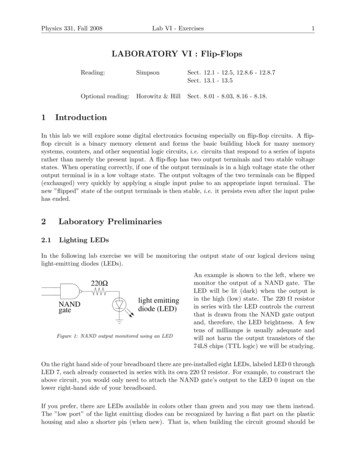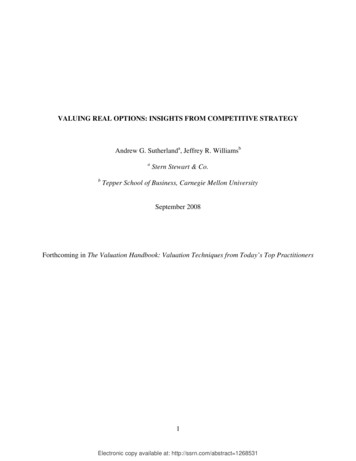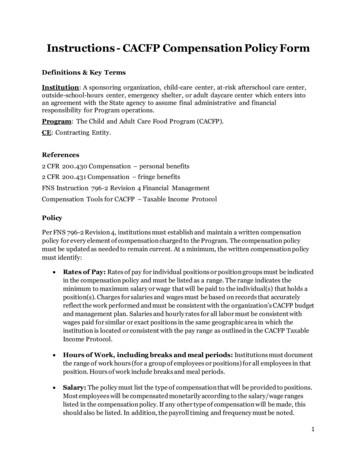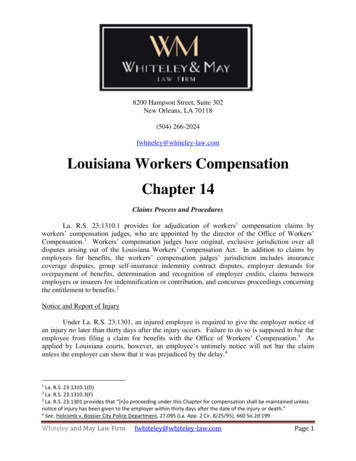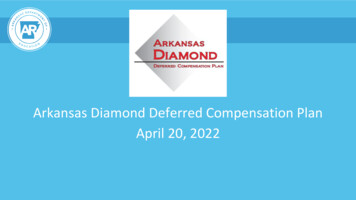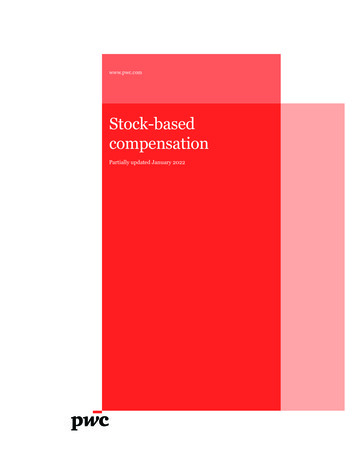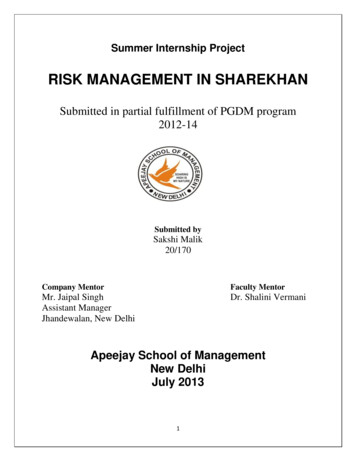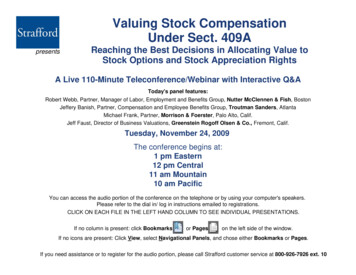
Transcription
Valuing Stock CompensationUnder Sect. 409ApresentsReaching the Best Decisions in Allocating Value toStock Options and Stock Appreciation RightsA Live 110-Minute Teleconference/Webinar with Interactive Q&AToday's panel features:Robert Webb, Partner, Manager of Labor, Employment and Benefits Group, Nutter McClennen & Fish, BostonJeffery Banish, Partner, Compensation and Employee Benefits Group, Troutman Sanders, AtlantaMichael Frank, Partner, Morrison & Foerster, Palo Alto, Calif.Jeff Faust, Director of Business Valuations, Greenstein Rogoff Olsen & Co., Fremont, Calif.Tuesday, November 24, 2009The conference begins at:1 pm Eastern12 pm Central11 am Mountain10 am PacificYou can access the audio portion of the conference on the telephone or by using your computer's speakers.Please refer to the dial in/ log in instructions emailed to registrations.CLICK ON EACH FILE IN THE LEFT HAND COLUMN TO SEE INDIVIDUAL PRESENTATIONS.If no column is present: click Bookmarksor Pageson the left side of the window.If no icons are present: Click View, select Navigational Panels, and chose either Bookmarks or Pages.If you need assistance or to register for the audio portion, please call Strafford customer service at 800-926-7926 ext. 10
For CLE purposes, please let us knowhow many people are listening at yourlocation by closing the notification box, clicking the chat button in the upperright corner, and typing in the chat box yourcompany name and the number ofattendees. Then click send.
Valuing Stock CompensationUnder Section 409A WebinarNov. 24, 2009Background ConceptsRobert D. Webb, Esq.rwebb@nutter.comNutter McClennen & Fish LLPWorld Trade Center West155 Seaport BoulevardBoston, Massachusetts 02210Telephone 617.439.2000www.nutter.com
Overview Of 409A Valuation RulesSignificance of valuation under Sect. 409ANon-qualified deferred compensation arrangementssubject to 409A do not include: ISOs ESPPs, and Non-statutory options (and related equity-basedcompensation, e.g. SARs), provided the exercise priceis not below FMVNutter McClennen & Fish LLP www.nutter.com2
Overview Of 409A Valuation Rules(Cont.)Permissible 409A valuation methodologies Readily tradable securities––––LSB/FSA: Last sale before or first sale after grantClosing price on grant date (or prior trading day)Mean of high/low trading prices on grant date (orprior trading day), andAverage selling price during specified period within30 days before or after applicable valuation dateNutter McClennen & Fish LLP www.nutter.com3
Overview Of 409A Valuation Rules(Cont.)Permissible 409A valuation methodologies (Cont.) General rule for non-readily tradable securities(NRTS)– FMV equals “a value determined by thereasonable application of a reasonablevaluation method” (Treas. Reg. Sect. 1.409A1(b)(5)(iv)(B))– The determination of whether a valuationmethod is reasonable, or whether anapplication of a method is reasonable, is madebased on the facts and circumstances as of thevaluation dateNutter McClennen & Fish LLP www.nutter.com4
NRTS Valuation - Relevant FactorsFactors to be considered under a reasonable valuationmethod for NRTS include, as applicable: The value of tangible and intangible assets of theissuer of the shares The present value of future cash-flows of the issuerof the shares “Other relevant factors” such as (1) controlpremiums or discounts for lack of marketability.and (2) whether the valuation method is used forother purposes that have a material economic effecton the issuer, its stockholders or its creditors; andNutter McClennen & Fish LLP www.nutter.com5
NRTS Valuation - Relevant Factors(Cont.)Factors to be considered for NRTS (Cont.) The market value of stock or equity interests insimilar corporations and other entities engagedin trades or businesses substantially similar tothose engaged in by the issuer, the value ofwhich can be readily determined through nondiscretionary, objective means (such as throughtrading prices on an established securitiesmarket or an amount paid in an arm’s lengthprivate transaction); for example, recent arm’slength transactions involving the sale or transferof such stock or equity interestsNutter McClennen & Fish LLP www.nutter.com6
NRTS Valuation - Relevant Factors(Cont.) Methodology must consider all information available. Allavailable information material to the value of the issuer mustnot take into consideration in applying its methodology Use of prior valuations. The use of a value previouslycalculated under a valuation method will not be deemedreasonable as of a later date if (i) the calculation fails toreflect information available after the date of the valuationthat may materially affect the issuer’s value, or (ii) the valuewas calculated with respect to a date more than 12 monthsearlier than the date for which the valuation is being usedNutter McClennen & Fish LLP www.nutter.com7
NRTS Valuation - Relevant Factors(Cont.) Consistency. The issuer’s consistent use of avaluation method to determine the value ofshares or its assets for other purposes, includingfor purposes unrelated to compensation ofservice providers, is also a factor supporting thereasonableness of the valuation methodNutter McClennen & Fish LLP www.nutter.com8
Valuation Methods Presumed ToBe Reasonable1. Current AppraisalA valuation of a class of stock determined by anindependent appraisal that meets the requirementsof Sect. 401(a)(28)(C) of the Code, and the TreasuryRegulations thereunder, as of a date that is no morethan 12 months before the relevant transaction towhich the valuation is applied (for example, thegrant date of a stock option)Nutter McClennen & Fish LLP www.nutter.com9
Valuation Methods Presumed ToBe Reasonable (Cont.)2. Start-up companiesWith respect to illiquid stock of a start-upcorporation, a valuation made reasonably and ingood faith and evidenced by a written report thattakes into account the relevant factors describedpreviouslyNutter McClennen & Fish LLP www.nutter.com10
Presumption Of Reasonableness –Start-Up Companies Illiquid stock. Stock of a corporation that has nomaterial trade or business that it (or anypredecessor to it) has conducted for a period of10 years or more and has no class of equitysecurities that are traded on an establishedsecurities market, where such stock is notsubject to any put or call right or obligation ofthe corporation or other person to purchase suchstock other than (i) a right of first refusal uponan offer to purchase by a third party and (ii) aright or obligation that constitutes a lapserestriction.Nutter McClennen & Fish LLP www.nutter.com11
Presumption Of Reasonableness –Start-Up Companies (Cont.)Effect of anticipated CIC on presumption The presumption of reasonableness for start-upsis lost if the issuer (or grant recipient) mayreasonably anticipate, as of the time thevaluation is applied, that (i) the issuer willundergo a change-in-control event within the 90days following the action to which the valuationis applied, or (ii) make a public offering ofsecurities within the 180 days following theevent to which the valuation is applied (e.g., thegrant of an option or exercise of a stockappreciation right)Nutter McClennen & Fish LLP www.nutter.com12
Presumption of Reasonableness –Start-Up Companies (Cont.)Need for qualified valuation provider A valuation will not be treated as madereasonably and in good faith unless thevaluation is performed by a person or personsthat the issuer reasonably determines to bequalified to perform the valuation based on hisor her significant knowledge, experience (e.g.,at least five years of relevant experience),education or trainingNutter McClennen & Fish LLP www.nutter.com13
Valuation Methods Presumed ToBe Reasonable (Cont.)3. Formula pricing A valuation based upon a formula that, if used aspart of a non-lapse restriction (for purposes ofTreasury Regulations Sect. 1.83-3(h)) withrespect to the stock, would be considered to bethe FMV of the stock under TreasuryRegulations Sect. 1.83-5Nutter McClennen & Fish LLP www.nutter.com14
Valuing Stock Compensation Under Sect.409A WebinarNov. 24, 2009Evaluating The Need For A ValuationJeffery R. Banish, Esq.Troutman Sanders LLPBank of America Plaza, Suite 5200600 Peachtree Street, N.E.Atlanta, Georgia 723 telephone404.962.6750 facsimile1
409A Dramatically Alters Way PrivateCompanies Value Their Common Stock Previous practice of valuing common stock based on rule-of-thumbdiscounts is no longer appropriate, e.g., valuing common stock byreference to the value of the preferred stock, such as the old 10-to-1ratio Cursory board resolutions stating that the board has determined the fairmarket value of the common stock are no longer sufficient2
Third-Party Appraisals Are NotRequired Choice between in-house valuation or outside appraisal is driven by manyfactors One key factor is whether to adopt a “presumptive” valuation method so asto shift the burden to the IRS to have to prove that (i) the valuation is belowfair market value, and (ii) the valuation method or the application of thevaluation method was “grossly unreasonable” Any valuation method other than one of the “presumptive” valuationmethods places the burden on the company to support that the valuation isnot below fair market value3
General Rule Is Fair Market Value MustBe Determined By “ReasonableApplication Of A Reasonable ValuationMethod” Statement is not controversial but is not particularly helpful either Applies to common stock that is not readily tradable on an establishedsecurities market Two-part test: Reasonable method and reasonable application of themethod based upon the facts and circumstances Valuation should consider the value of tangible and intangible assets,present value of cash flows, market value of similar interests, recent arm’slength transactions, and other relevant factors4
General Rule Is Fair Market Value MustBe Determined By “ReasonableApplication Of A Reasonable ValuationMethod” (Cont.) Not reasonable if valuation does not consider all available materialinformation, e.g. cannot ignore third-part offer that is likely to be accepted Cannot rely on valuation that is more than 12 months old Cannot rely on an earlier valuation if the earlier valuation does notconsider information that becomes available after the earlier valuation,and the information is material to the determination of the value of thecommon stock Consistent use of method is a factor supporting its reasonableness5
409A Provides Three Presumptive “SafeHarbor” Valuation Methods Independent ESOP appraisal method Illiquid start-up company method Binding formula valuation method6
Independent ESOP Appraisal SafeHarbor Is Valuation Performed ByQualified Independent Appraiser, UsingTraditional Appraisal Methodologies Presumed reasonable if the valuation satisfies the rules for ESOPvaluations and is no more than 12 months old Must be performed by an independent appraiser7
Illiquid Start-Up Presumption Applies ToPrivate Companies Less Than 10 Years Old Valuation must be in writingMust be performed by person that company reasonably believes is qualifiedto perform valuations and has significant knowledge, experience (at least 5years), education or training in performing similar valuationsStock must not be subject to a put, call or other right (other than a right offirst refusal)Company must not be anticipating a change in control within the next 90days or an IPO within the next 180 daysValuation must take into account the value of tangible and intangiblecompany assets, the present value of cash flows, and control premiums anddiscounts for lack of marketability, among other factorsValuation may not be more than 12 months old8
Binding Formula Presumption Is ValuationBased On Consistent Application Of SingleFormula Used In All Stock Transfers Formula must apply for all stock transfers to the company and over-10%shareholders Formula must apply regardless of whether transfers are compensatory innature; reasonable if the formula is used for valuing stock for purposes ofthe company’s regulatory filings, loan covenants and sales to third parties.Exception is that formula need not apply to an arm’s length transactioninvolving the sale of all or substantially all of the company’s stock 9
Do You Need A Valuation? Should YouDo It In-House Or Hire IndependentAppraiser? Must do some type of valuation, e.g., rule-of-thumb discounts and cursoryreviews are no longer sufficient 409A expectation is for a more rigorous and defined valuation analysis todetermine the value of the common stock Company can retain outside appraisal firm, or the valuation can beperformed in-house or by a related party with the credentials and expertiseto perform valuations If company wants to shift the burden to the IRS and get the protection ofthe presumption, then it must satisfy one of the three safe harbor methods Otherwise, the burden will be on the company to prove that the valuedetermined for the common stock was not less than fair market value10
Factors To Consider Does in-house person or other related party have significant knowledge,experience (at least 5 years), education or training in performingvaluations? Would a reasonable person rely upon the advice of such in-house person orrelated party with respect to value, if the reasonable person was buying orselling stock of the company? Does the company anticipate a change in control in the next 90 days or anIPO in the next 180 days? Lack of qualified in-house person or related party with sufficientknowledge and training to perform valuation may lead to hiring an outsideappraiser11
Factors To Consider (Cont.) Is one of the safe harbor methods available? The IRS has stated that it willevaluate the company’s application of the method, not necessarily if the“number” is correct, so what the company did may outweigh the accuracyof the final valuation if the company complies with the safe harbor method The illiquid start-up presumption favors the company. The IRS has saidthat, if the company does not satisfy the presumption, the general rule stillapplies – “the reasonable application of a reasonable valuation method” So, company could still satisfy the general test, and the closer the valuationmethod is to the illiquid start-up method, the more likely it will satisfy thegeneral test (even for companies that have been in operation for more than10 years)12
Factors To Consider (Cont.) Cost is always a factor; outside appraisal can be expensive Discounted valuations by inexperienced appraisers may not be respected bythe IRS or others Complexity of the company’s capital structure must be considered indetermining the qualifications of the person who is to perform the valuation 409A valuations are much more involved, because first the enterprise valueof the company must be determined, second the relative values of thedifferent classes of equity of the company (with their different voting anddividend rights) must be determined, and third value then must be assignedto the company’s common stock13
Factors To Consider (Cont.) Consider if valuation is needed for other purposes, such as to determine theexpenses to recognize for accounting purposes Will valuation take into account the AICPA guidelines for valuing thestock? Likely that valuation that satisfies the AICPA guidelines will satisfy thegeneral test for the reasonable application of a reasonable valuation method(but a valuation sufficient for 409A may not work for the accountants) The IRS has said that it will not use hindsight to judge the valuation. So, intheory, later SEC or accounting problems should not be fatal to valuationfor purposes of 409A (although I would not want to rely on the IRS’statement in these types of circumstances)14
Practical Implications Type of valuation may differ depending on the stage of the privatecompany’s life cycle Different considerations at different stages: Start-up/founders stage, venturecapital and angel financing stage prior to expectations of a change incontrol or IPO and after the company anticipates a change in control or IPOstage15
Start-Up Stage Not likely to see formal appraisals in typical start-ups prior to the time thecompany has assets and begins operations May not need valuation if company makes initial equity awards in outrightgrants of stock or restricted stock or restricted stock units Still may be necessary to value company stock to determine income to berecognized by management and accounting expenses to be booked Performing precise valuation at this stage will be difficult due to thecompany’s lack of assets and financial history and relative inability toproject future earnings and cash flow from operations16
Post-Funding And Prior To Change InControl Or IPO The company might consider an independent appraisal of the value of itscommon stock once assets are acquired and operations begin No clear time when, or if ever, the company reaches the stage of needingan independent appraisal Initial or subsequent venture capital or angel financing rounds could resultin investors’ requiring an independent appraisal Company board will need to determine, with the assistance of counsel,whether an outside valuation is advisable At this stage, complex capital structure of the company with differentfinancing layers may dictate going outside the company for advice17
Post-Funding And Prior To Change InControl Or IPO (Cont.) Board will need to weigh desire to satisfy a safe harbor method (to get theprotection of the presumption) against the cost of an outside appraisal andthe availability of in-house expertise to perform the valuation Events, such as subsequent rounds of financing, third-party offers or otherevents, may invalidate prior appraisals May be costly to have regular valuations throughout the year, which coulddrive the company to consider annual grants at set times so as to minimizethe times valuations are needed May be able to rely on illiquid start-up presumption being satisfied by awritten report prepared by the company’s internal financial personnel or aboard member with experience or training in stock valuations Not unusual for board member appointed by venture capital investor toassist with the valuation Not unusual to use independent appraiser to set annual valuation and relyon qualified in-house person to update the valuation during the year18
After Expectation Of Change In ControlOr IPO Once the company reasonably anticipates a change in control in the next 90days or an IPO in the next 180 days, it may not rely on the illiquid start-uppresumption. However, the company could still follow the same rules tosatisfy the general valuation test Companies at this stage may want to consider using an independentappraiser, especially if needed to avoid “cheap stock” issues with the SEC Auditors and accountants at this stage may require independent appraisalsfor financial accounting purposes Buyers may be concerned about compliance with 409A and wantassurances that the company has not granted discounted options or stockappreciation rights that are not exempt from 409A19
General Conclusions 409A will require more rigorous valuations than in the past No longer have the leeway previously permitted in prior valuations such aswhen valuing common stock for purposes of issuing incentive stockoptions Investors or accountants may require independent valuations for variousreasons Company must weigh cost of outside appraisal firm against its ability toperform the valuation in-house with internal people or other related partieswho have the appropriate experience, education or expertise Valuation in any event must be performed by someone with the credentialsand expertise to do so No easy answer20
General Conclusions (Cont.) Company should be able to protect itself by performing the valuation in away consistent with the illiquid start-up presumption, even if it is nottechnically available (if not using an independent appraiser) Safest choice would be to obtain an independent, third-party valuationcontemporaneously with the time of the proposed equity grants If obtaining an independent valuation, hire an appraiser with experience (i)in the company’s industry and (ii) with other companies in the same lifecycle stage as the company21
General Conclusions (Cont.) Is best to involve accountants early in the process to avoid costly mistakessuch as where the 409A valuation does not take into account AICPAvaluation guidelines and is rejected by the accountants The company should draft its equity awards with appropriate language toprotect itself, if the IRS challenges the valuation, by including a provisionthat says the company is not liable if the award becomes subject to 409Aand fails to comply with the 409A requirements22
Valuing Stock Compensation Under Sect.409A WebinarNov. 24, 2009Evaluating Total ExposureJeffery R. Banish, Esq.Troutman Sanders LLPBank of America Plaza, Suite 5200600 Peachtree Street, N.E.Atlanta, Georgia 723 telephone404.962.6750 facsimile1
Downside Of Getting TheValuation Wrong Option or stock appreciation right likely subject to 409A Non-compliance could result in recognition of income from the award atthe time of vesting, plus additional 20% tax Company required to remit applicable tax withholdings at the time ofincome recognition (not including the additional 20% tax); failure to do soresults in payment of interest and tax penalties Incentive stock options may be disqualified and treated as non-qualifiedoptions Cheap stock problem on IPO that could require additional financialaccounting expenses to be recognized2
Downside Of Getting TheValuation Wrong (Cont.) 409A problems likely to result in disgruntled management Could result in violation of the company’s financing arrangements, loancovenants and other agreements Risk of lawsuits for improper certifications that no 409A problems existedor that stock options or stock appreciation rights were not issued “in-themoney” Management and shareholders could be personally liable Additional costs to then obtain valuation that auditors will accept3
Valuing Stock CompensationUnder Section 409A WebinarNov. 24, 2009How Much To Reveal To An Outside ValuationSpecialistMichael T. FrankMorrison & Foerster LLP755 Page Mill RoadPalo Alto, CA 94304-1018(650) 813-5600mfrank@mofo.comwww.mofo.com 2009 Morrison & Foerster LLP All Rights Reserved
What Should We Share With Our OutsideValuation Experts? Regulations say a valuation method will not be considered reasonable if itdoes not take into account all information material to the company’svaluationFactors to be considered include: The value of the company’s tangible and intangible assets The present value of the company’s future cash flows The market value of equity interests in substantially similar businessesthat can be determined readily by objective means The effects of any control premiums and/or marketability discounts Recent arm’s length transactions involving the sale or transfer of thestock or equity interests Whether the proposed valuation method is used for other purposes thatmaterially affect the company, its shareholders, or creditors; and Other relevant factors2
What Should We Share With Our OutsideValuation Experts? (Cont.) The IRS will not consider a valuation method to be reasonable if it fails totake into account all information that is material to the company’s valuationA value that was previously determined under an otherwise reasonablemethod will not be considered to be reasonable for purposes of CodeSect. 409A if either the determined value does not reflect after-acquiredinformation with material effects on the company’s current value, or thevalue was determined as of a date more than 12 months before the date forwhich the valuation is being usedExamples from regulations Resolution of material litigation Issuance of a patentDoes it matter if the new information is negative rather than positive?3
Valuing Stock CompensationUnder Section 409A WebinarNov. 24, 2009Practical Interworkings With Outside ValuationFirmMichael T. FrankMorrison & Foerster LLP755 Page Mill RoadPalo Alto, CA 94304-1018(650) 813-5600mfrank@mofo.comwww.mofo.com 2009 Morrison & Foerster LLP All Rights Reserved
409A Valuation Vs. FAS Calculations What to do if there is a discrepancy Minority discounts IPO run-up “cheap stock” issue SEC linear approach 409A “facts at the time” approach2
What If You Are Approaching The 12-MonthAnniversary Of Your Last Valuation? “Refresh” valuation? Will this permit an additional 12 months of reliance? New valuation? What if the interim information is negative? Can a company safely revise downward from an outside valuation?3
Valuing Stock CompensationUnder Section 409A WebinarNov. 24, 2009Decisions forced by in-house execs, outside advisorsJeff Faust, jfaust@groco.comGreenstein, Rogoff, Olsen & Co.
Decisions Forced By Others Actions by internal executives and investors can affect the process andoutcome of the 409A valuation This includes: Outside stock transactions Stock sales between executives and board Stock purchased from departing executives Follow-on rounds that have different terms (and a different premoney valuation)Greenstein, Rogoff, Olsen & Co.2
Decisions Forced By Others (Cont.) Depending on how much “weight” is put on the outsidetransaction, the valuation could dramatically changeGreenstein, Rogoff, Olsen & Co.3
Decisions Forced By Others (Cont.) Sample of how these actions affect the valuation (#1)METHODS UTILIZEDAPPRAISED VALUE OFTOTAL EQUITYIncome ApproachesDiscounted Net Cash Flow to Equity (DCF)Capitalized Net Cash Flow to EquityDiscounted Future Earnings (DFE)Capitalized Earnings6,318,6976,763,6055,385,9295,461,612Market ApproachesGuideline Company MethodComparative Transaction MethodVenture Capital Method6,986,4516,161,4076,339,571WEIGHTWEIGHTED VALUE OFTOTAL EQUITY100%6,318,697100%6,318,697OthersCompany Specific Transaction10,181,040Greenstein, Rogoff, Olsen & Co.4
Decisions Forced By Others (Cont.) Sample of how these actions affect the valuation (#2)METHODS UTILIZEDAPPRAISED VALUE OFTOTAL EQUITYIncome ApproachesDiscounted Net Cash Flow to Equity (DCF)Capitalized Net Cash Flow to EquityDiscounted Future Earnings (DFE)Capitalized Earnings6,318,6976,763,6055,385,9295,461,612Market ApproachesGuideline Company MethodComparative Transaction MethodVenture Capital Method6,986,4516,161,4076,339,571WEIGHTWEIGHTED VALUE OFTOTAL ompany Specific Transaction10,181,040Greenstein, Rogoff, Olsen & Co.5
Decisions Forced By Others (Cont.) Sample of how these actions affect the valuation (#3)METHODS UTILIZEDAPPRAISED VALUE OFTOTAL EQUITYIncome ApproachesDiscounted Net Cash Flow to Equity (DCF)Capitalized Net Cash Flow to EquityDiscounted Future Earnings (DFE)Capitalized Earnings6,318,6976,763,6055,385,9295,461,612Market ApproachesGuideline Company MethodComparative Transaction MethodVenture Capital Method6,986,4516,161,4076,339,571WEIGHTWEIGHTED VALUE OFTOTAL ompany Specific Transaction10,181,040Greenstein, Rogoff, Olsen & Co.6
Decisions Forced By Others (Cont.) Sample of how these actions affect the valuation (#4)METHODS UTILIZEDAPPRAISED VALUE OFTOTAL EQUITYIncome ApproachesDiscounted Net Cash Flow to Equity (DCF)Capitalized Net Cash Flow to EquityDiscounted Future Earnings (DFE)Capitalized Earnings6,318,6976,763,6055,385,9295,461,612Market ApproachesGuideline Company MethodComparative Transaction MethodVenture Capital Method6,986,4516,161,4076,339,571WEIGHTWEIGHTED VALUE OFTOTAL ompany Specific Transaction10,181,040Greenstein, Rogoff, Olsen & Co.7
Decisions Forced By Others (Cont.) Sample of how these actions affect the valuation (#5)METHODS UTILIZEDAPPRAISED VALUE OFTOTAL EQUITYIncome ApproachesDiscounted Net Cash Flow to Equity (DCF)Capitalized Net Cash Flow to EquityDiscounted Future Earnings (DFE)Capitalized Earnings6,318,6976,763,6055,385,9295,461,612Market ApproachesGuideline Company MethodComparative Transaction MethodVenture Capital Method6,986,4516,161,4076,339,571WEIGHTWEIGHTED VALUE OFTOTAL EQUITYOthersCompany Specific reenstein, Rogoff, Olsen & Co.8
Decisions Forced By Others (Cont.) Sample of how these actions affect the valuation stein, Rogoff, Olsen & Co.9
Decisions Forced By Others (Cont.) What factors are looked at to determine how much weight to puton the outside transaction? Size of the transaction Date of the transaction Parties involved (arms-length negotiation vs. insider deal) Anything else relevantGreenstein, Rogoff, Olsen & Co.10
Valuing Stock CompensationUnder Section 409A WebinarNov. 24, 2009Making Decisions With LimitedGuidanceRobert D. Webb, Esq.rwebb@nutter.comNutter McClennen & Fish LLPWorld Trade Center West155 Seaport BoulevardBoston, Massachusetts 02210Telephone 617.439.2000www.nutter.com
Correction MethodsAvailability of reliefApplies if, during a grant recipient’s taxable year: A covered failure occurs, and The correction requirements are satisfiedEffect of relief The stock right is treated from the date of grantas not providing for a deferral of compensationfor purposes of 409ANutter McClennen & Fish LLP www.nutter.com2
Correction Methods (Cont.)Covered operational failure A failure eligible for correction under theTreasury guidance consists of a stock right thatsatisfies all requirements to be excluded fromcoverage under 409A, except that the exe
Overview Of 409A Valuation Rules (Cont.) Permissible 409A valuation methodologies (Cont.) General rule for non-readily tradable securities (NRTS) - FMV equals "a value determined by the reasonable application of a reasonable valuation method" (Treas. Reg. Sect. 1.409A-1(b)(5)(iv)(B)) - The determination of whether a valuation
